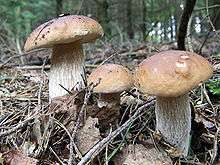Boletus
Boletus is a genus of mushroom-producing fungi, comprising over 100 species. The genus Boletus was originally broadly defined and described by Carl Linnaeus in 1753, essentially containing all fungi with hymenial pores instead of gills. Since then, other genera have been defined gradually, such as Tylopilus by Petter Adolf Karsten in 1881, and old names such as Leccinum have been resurrected or redefined. Some mushrooms listed in older books as members of the genus have now been placed in separate genera. These include such as Boletus scaber, now Leccinum scabrum, Tylopilus felleus, Chalciporus piperatus and Suillus luteus. Most boletes have been found to be ectomycorrhizal fungi, which mean that they form a mutualistic relationship with the roots system of certain kinds of plants[3]. More recently, Boletus has been found to be massively polyphyletic, with only a small percentage of the over 300 species that have been assigned to Boletus actually belonging there and necessitating the description and resurrection of many more genera.[2][4][5][6]
| Boletus | |
|---|---|
 | |
| Boletus edulis | |
| Scientific classification | |
| Kingdom: | Fungi |
| Division: | Basidiomycota |
| Class: | Agaricomycetes |
| Order: | Boletales |
| Family: | Boletaceae |
| Genus: | Boletus L. (1753) |
| Type species | |
| Boletus edulis Bull. (1782) | |
| Diversity | |
| over 100 species | |
| Synonyms[1][2] | |
The name is derived from the Latin term bōlētus 'mushroom' from the Ancient Greek βωλίτης, bōlitēs,[7] ultimately from βῶλος, bōlos 'lump' or 'clod'.[8] However, the βωλίτης, of Galen is thought to have been the much prized Amanita caesarea.[9]
Edibility
The genus Boletus contains many members which are edible, such as Boletus edulis, Boletus aereus and Boletus barrowsii.
See also
- Bolete eater, a fungal parasite of various Boletus species
- List of Boletus species
References
- "Boletus L." Species Fungorum. CAB International. Retrieved 2014-02-04.
- Nuhn ME, Binder M, Taylor AF, Halling RE, Hibbett DS (2013). "Phylogenetic overview of the Boletineae". Fungal Biology. 117 (7–8): 479–511. doi:10.1016/j.funbio.2013.04.008. PMID 23931115.
- "Boletus edulis, Cep, Penny Bun Bolete mushroom". www.first-nature.com. Retrieved 2020-05-18.
- Binder M, Hibbett DS (2006). "Molecular systematics and biological diversification of Boletales". Mycologia. 98 (6): 971–81. doi:10.3852/mycologia.98.6.971. PMID 17486973.
- Dentinger B, Ammirati J, Both EE, Desjardin D, Halling RE, Henkey TW, Moreau PA, Nagasawaa E, Soytong K, Taylor A, Watling R, Moncalvo J, McLaughlin D (2010). "Molecular phylogenetics of porcini mushrooms (Boletus section Boletus)". Molecular Phylogenetics and Evolution. 57 (3): 1276–92. doi:10.1016/j.ympev.2010.10.004. PMID 20970511.
- Wu, Gang; Feng, Bang; Xu, Jianping; Zhu, Xue-Tai; Li, Yan-Chun; Zeng, Nian-Kai; Hosen, Md. Iqbal; Yang, Zhu L. (2014). "Molecular phylogenetic analyses redefine seven major clades and reveal 22 new generic clades in the fungal family Boletaceae". Fungal Diversity. 69 (1): 93–115. doi:10.1007/s13225-014-0283-8.
- Simpson, D.P. (1979). Cassell's Latin Dictionary (5 ed.). London: Cassell Ltd. p. 883. ISBN 0-304-52257-0.
- Liddell, Henry George and Robert Scott (1980). A Greek-English Lexicon (Abridged ed.). United Kingdom: Oxford University Press. ISBN 0-19-910207-4.
- Ramsbottom J (1953). Mushrooms & Toadstools. Collins. p. 6. ISBN 1-870630-09-2.